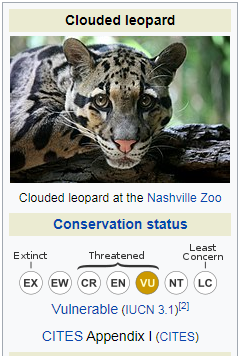Clouded leopard

Copyright infringement is not intended
Context: A clouded leopard photographed near the summit of Mt Saramati in Nagaland’s Thanamir village.
- The findings have been published in the Winter 2021 issue of the Cat News.
- Cat News is the IUCN/Species Survival Commission (SSC) Cat Specialist Group’s biannual newsletter.
About clouded leopard (Neofelis nebulosa):
- Local name: In the local dialect of the indigenous Yimkhiung tribe, the clouded leopard is known as “Khephak”, which means a greyish big cat.
- It uses its tail for balancing when moving in trees and is able to climb down vertical tree trunks head first.
- It rests in trees during the day and hunts by night on the forest floor.
- Threats for its survival: large–scale deforestation and commercial poaching for the wildlife trade.
- Range: This wild cat inhabiting dense forests from the foothills of the Himalayas through mainland Southeast Asia into South China.
- Distribution or habitat in India: In India, it occurs in Sikkim, northern West Bengal, Meghalaya subtropical forests, Tripura, Mizoram, Manipur, Assam, Nagaland and Arunachal Pradesh.
- Protection status:
- ‘Vulnerable’ under the IUCN Red List of Threatened Species.
- CITES: APPENDIX 1
- Conservation efforts: The Clouded Leopard Project is dedicated to the conservation of clouded leopards and their habitat by supporting field research, implementing education initiatives in range countries, and bringing global awareness to clouded leopard conservation issues.
https://indianexpress.com/article/north-east-india/nagaland/clouded-leopard-sighted-nagaland-mountains-7709328/



1.png)
